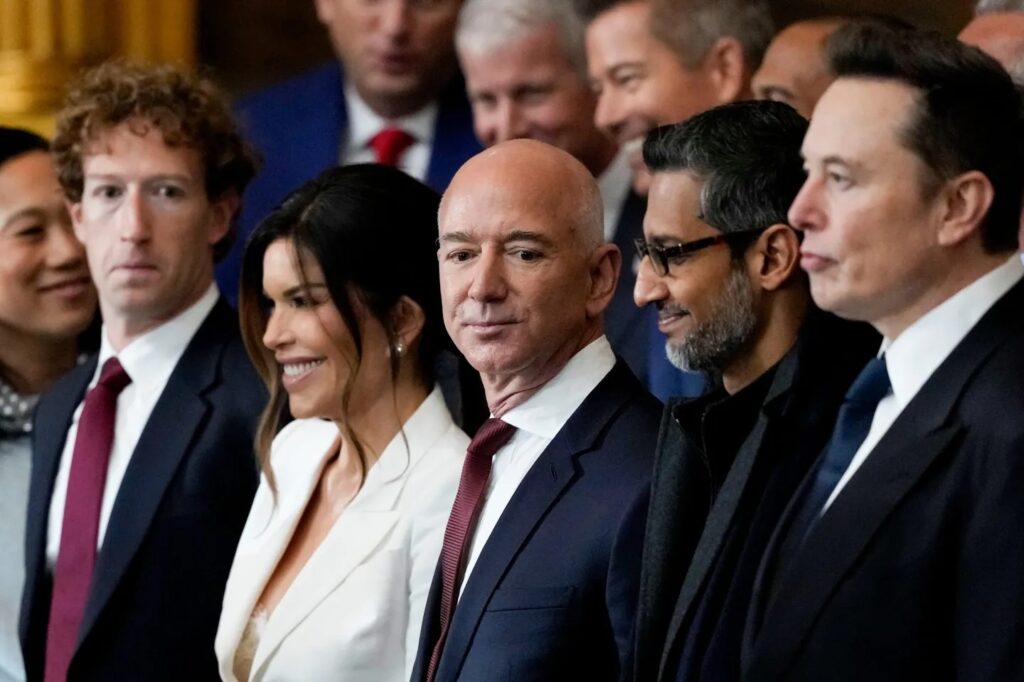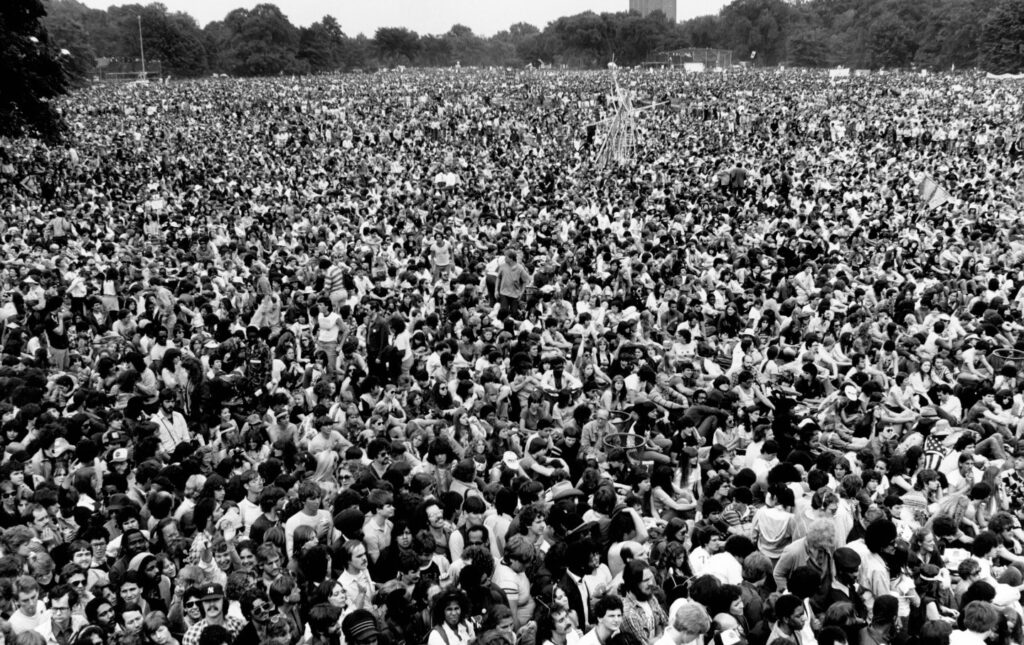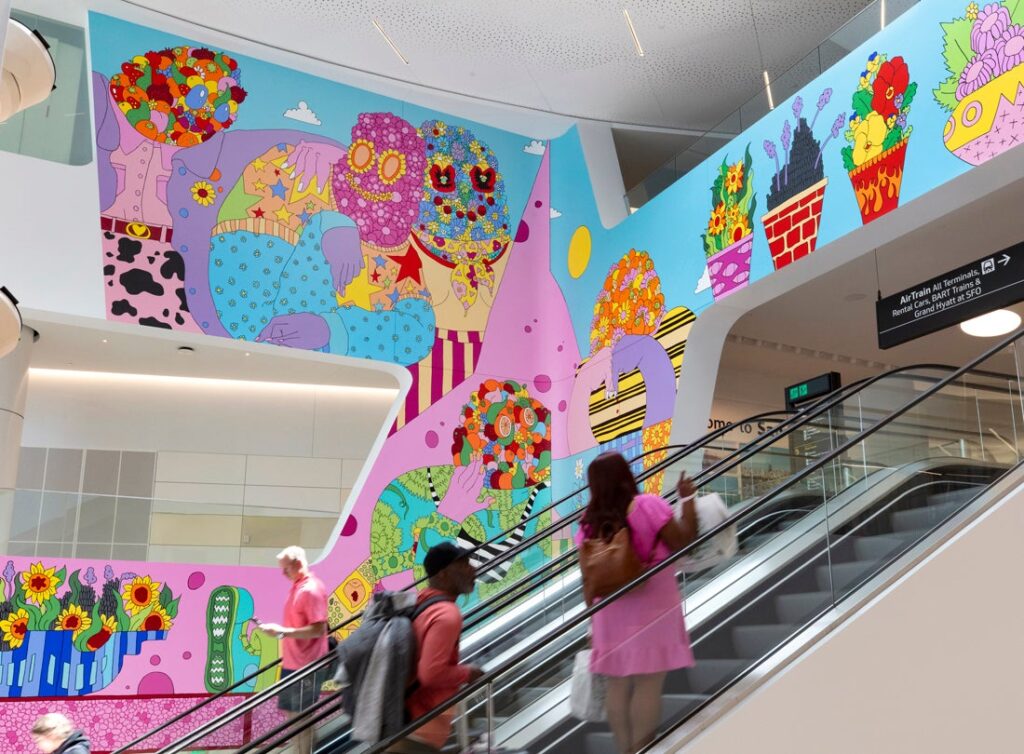In the public imagination, the ’80s are mostly known for their neon outfits, hypotenoid haircuts, gender-bending celebrities, and indelible music. The period glows like a zenith of personal expression. But in truth, it was a suffocatingly conformative era in which publicly defiant actions—except those deemed fashionably rebellious—were all but snuffed out. The Moral Majority was ascendant under the deregulatory fist of Reagan, combining religious and libertarian oppression into a molten reactionary goo, which froze any broad US movement for economic, political, and social justice in place.
Young Republicans took over colleges and reversed the decades-long trend of campuses as hotbeds of protest, Black and Brown civil rights were rolled back, preppy ideology codified Wall Street greed and genteel bourgeois capitalism as the decade’s mainstream vibe. Combine all that with the acceptably blatant homophobia, racism, sexism, and anti-poor sentiment of the time… Let’s just say it was not a good moment to be a hippie-type who cared deeply about social justice in their community (especially since most of the original hippie types appeared to have caved into their own cocaine-laced avarice).
Growing up in that time as femme-y, out gay Arab boy in the Metro Detroit area famously known as the Reagan Democrats, it was amazing to watch as the people around me hardened from New Deal union diehards or benevolent white collar types into intolerant Stepford wannabes clucking about “personal responsibility” and “American [white Christian] values,” even as their auto industry jobs evaporated and they began to test their safety own nets.
Then there was the socially conservative backlash to the revolutions of the ’60s and ’70s: With AIDS allowed to run rampant by the government, people on TV regularly screaming that you were going to hell, and the mind-boggling hypocrisy of high school jocks in pink Polo shirts with glossy magazine photos of hair metal singers wearing mascara and nylons in their lockers beating you up regularly because you were gay and Goth/New Wave, it’s a wonder many people like me survived. Narrator voice: They didn’t.

I can’t help recalling those stifling times as we watch corporate and political leaders fall in line behind MAGA Trumpism, which is bringing back “greed is good” and social conformity on a scale I haven’t felt since that decade, or at least since the beginning of the Bush II years, this time with an undisguised fascist edge. Even Trump’s first term didn’t feel quite so much like the sky was falling in.
Corporate tech “leaders,” who possess all of our personal information down to potentially our latest bowel movement, now grovel publicly, debasing themselves so they can further impoverish US workers with an onslaught of untested AI. Politicians once thought to be at the very least liberal throw trans people and anti-genocide protesters under the bus. Foreign authoritarians take pride of place. Greasy grifters and Botoxed religious harridans are put centerstage—you can literally watch them stick their hands in passing rubes’ pockets.
Like many, I couldn’t bring myself to witness the inaugural bonfire of inanities last week, but the clips coming from it—from “Girls Gone Bible” and a lumbering Village Person to Elon Musk’s Nazi salute—cemented this acrid vibe-shift. It felt like all the worst people in the world were gathered in one place, gloating over their astonishingly successful scam. Bring on the drones! The rest of the week was downhill from there, with… well, either you’re glued to or ignoring the news, so no need to recount all the sopping calamities and idiot parades.
But here’s the thing, at least about the 1980s. There were fantastic protest movements happening, even if they’ve been obscured by history. ACT-UP, of course, is one—harnessing the power of “identity politics” (a dirty phrase these days, apparently) to save millions of queer and other lives from the AIDS death sentence. Anti-apartheid and Central American anti-US imperialism solidarity movements were in full swing; Anti-nuclear and environmentalist protests drew record numbers. Witchy gay protests peeked out from odd corners. We can learn so much from listening to their elders and studying their actions.

I can’t tell you how much music mattered back then, too, from the miraculous chart-topping weirdness of New Wave and the heady swirl of contemporary “new music,” to the flowering of hip-hop and the birth of indie, to outright protest songs on the radio. Grandmaster Flash, the Clash, Tracey Chapman, Frankie Goes to Hollywood, even NWA on the airwaves? Unimaginable. There’s a reason punk finally took hold in the US in the ’80s, thrashing out as hardcore (although the Nazis tried to take that over, and mostly lost). And of course house music and techno, freestyle and electro, took us out on the dance floors. Music was a tremendous, and tremendously inventive, release valve.
And then there was the art. I don’t subscribe to the over-generalization that oppression makes for great art (who would wish for that!) and many rue the commercialization of graffiti and the market hyperinflation of ’80s art into mere “parked capital.” But when you had Basquiat, Haring, Scharf, Futura, Lady Pink, and Fab Five Freddy hitting the subways and Gorilla Girls, Robert Mapplethorpe, Nan Goldin, Jenny Holzer, Barbara Kruger, David Wojnarowicz, the NEA 4, and other outspoken political artists taking over the galleries, it was a wild time that left a radiant streak of radical resistance through contemporary art history. And that’s just the visual output—the drag, theater, cuisine, fashion, performance, so much was pushing us past despair.
So. The 1980s were full of bullies in power and kind of truly sucked, but our spirit made it through—singing, dancing, creating, and protesting. There’s tons of great music and art happening now, as well. We can harness it to survive, and make more. In fact, one great piece of art in particular put me in mind of how we can persevere in the current moment.
I flew back from a family visit to the East Coast last week, as LA continued burning and 10-inch snow hit New Orleans, trying to unclench my jaw from all the stress of this ridiculous country (and knowing that my travels complicitly contributed to the crazy weather). It was an incredible balm to pull into SFO’s bright and shiny new Harvey Milk terminal—still a radical-seeming acknowledgment of gay love, even of they’ve pulled the photo of the White Night Riots’ burning police car off the wall.

Especially fabulous was the very colorful, very queer, and very ’80s-feeling new mural by San Francisco artist Craig Calderwood titled “The Only Blue Is the Sky.” It explodes across walls surrounding the escalators on the main floor, embracing travelers in a brilliant vision of flowers, fruits, and fantastical creatures.
“Histories are non-linear,” says the art’s description, “relying on a diverse constellation of signifiers and people to order and give meaning to the chaos of the past. Calderwood’s work ties together various signs to highlight a queer network, connecting ideas of desire, resistance, deviance, kinship, and alternative family structures throughout history. This colorful tableau also reflects the multifaceted nature of queer identity and expresses Milk’s utopian ideas of making life for those who live outside of the mainstream easy, comfortable, and joyful.”
While it may not directly be addressing the crises and hatred we’re undergoing (again), the mural reminded immediately how art can lift you out of a dreary gutter and up into the stars, connecting you with zillions of others who are on the same journey. It was literally a bright spot in a terrible week, in a terrible year.
We’re going to need a lot more of these, but they’re there. And they’ll be what we’re best remembered by.





